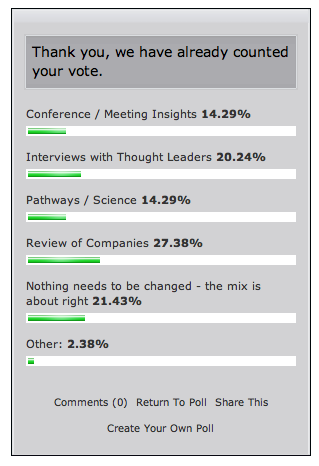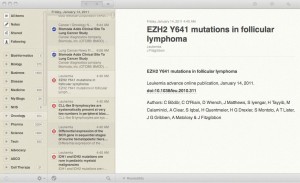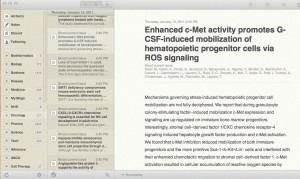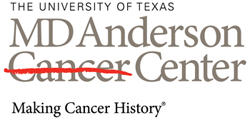Back from Milan and ESMO 2010, I thought it would be a good idea to quick a final quick overview of some of the early data from phase II trials that look interesting and might be worth watching as the research evolves (in no particular order).
1. Addition of cetuximab to cisplatin increased survival in triple negative breast cancer
Jose Baselga presented the results of a multi-centre randomised trial (from Spain, Belgium, Austria, Portugal, the UK and Israel) that compared the combination of cetuximab (Erbitux) with cisplatin versus cisplatin alone in 173 women with triple negative breast cancer (TNBC).
Although the overall response rate (ORR) trended in favour of the combination (20.0 vs 10.3%), the result did not meet the pre-specified assumptions. Interestingly though, the progression-free survival (PFS) showed a significant improvement with the addition of cetuximab (3.7 vs 1.5 months, P<0.03). Two months doesn't seem much, but in an advanced, highly aggressive disease, it may represent a disproportionally large improvement.
I'm not sure why cisplatin was chosen as a comparator, especially as TNBC is a particularly hard subset to treat, but the trial is ongoing to determine overall survival and a phase III study will likely evolve to determine if the results are repeatable in a larger population.
2. GSK2118436 in advanced melanoma with brain mets looks promising in a phase I/II study
By promising, I mean this was a very small cohort of patients who saw some early and unexpected evidence of tumour shrinkage in brain mets that had evolved from primary melanoma. The scans shown by the presenter, Georgina Long, from the Melanoma Institute Australia and Westmead Hospital in Sydney actually gave me goosebumps and it wasn't the chill in the room. You just don't expect to see such noticeable shrinkage with a single agent in this setting because this is a horrid, aggressive disease that has a nasty tendency to metastasize easily.
What was interesting about this study is that GSK2118436 is a BRAF inhibitor that also specifically targets V600E, similarly to Plexxikon/Roche's PLX4032. In both cases, they bind to the protein and shut down signaling activity. Although the trial is very early, since it looked at 3 different cohorts, the small subset with brain mets (n=10) were what caught everyone in the audience's attention, although good responses were also seen in the advanced melanoma group without brain mets.
To put the results in context, all 10 patients experienced some control of their brain mets, with 9 of the 10 patients having reductions in the overall size of their tumours. The overall reductions ranged from 20-100% of brain metastases that were 3mm or larger in diameter before treatment.
That just doesn't happen with advanced melanoma with brain mets… at least, I've never seen such dramatic responses before.
The big questions for me are how long will the responses be durable before resistance sets in and how soon is a larger scale trial going to get up and running? This is a very promising and most unexpected development that is worth following.
Dr Long summed it up very nicely:
“The ability to inhibit oncogenic BRAF is the most important development in the history of drug treatment of melanoma.”
3. ARQ-197 continues to show positive results in NSCLC
In this presentation, the final results of the phase II trial in non-small cell lung cancer (NSCLC) were discussed. We've covered this promising agent, ARQ-197 (ArQule/Daiichi Sankyo), a small molecule c-MET inhibitor, before on this blog.
A final analysis looked at the complete results in more depth. Patients treated with ARQ 197 plus erlotinib (Tarceva) developed new metastases in a median time of 7.3 months compared with 3.6 months for patients treated with erlotinib plus placebo.
What I found interesting in this study was that this effect was more pronounced among patients with non-squamous (NS) histology, since the median time to develop new metastases was 11.0 months in the ARQ 197 plus erlotinib arm compared to 3.6 months for those treated with the control arm (erlotinib plus placebo). I'm not sure why the NS over squamous histology should matter, but they clearly benefitted more.
The sponsors, ArQule and Daiichi Sankyo, have announced that they plan to pursue a phase III trial in this setting. It would, however, be nice to see an analysis of any lung biopsies collected to see if there are any relevant biomarkers that would explain the differences in histology and responders, otherwise many physicians may see this as an incremental improvement, if confirmed in a larger trial. Were thre any differences in people who were EGFR mutation or MET positive, for example?
There was certainly some energetic discussion in the Q&A, with tough questions asked of the speaker regarding why go ahead with a phase III study given a small benefit and why use OS when PFS is small and complicated by crossover, all very fair questions. Like many, I'd really like to see more granular analysis of who is responding to this agent and why before rushing into a phase III trial that may see a disappearing of any positive signal when investigator bias is eliminated in a larger randomised trial.
4. METMAB showed promising results in a subset of lung cancer patients
In the same session, David Spiegel presented the data from a phase II study with a different c-MET inhibitor. Here, patients with advanced NSCLC (n=128) were randomly assigned to receive either erlotinib plus METMAb (Roche/Genentech), a monoclonal antibody that binds specifically to the MET receptor on cancer cells or a control arm (erlotinib plus placebo).
The reason for the interest in c-MET inhibitors is that MET activation has been implicated in the resistance of lung cancers to EGFR inhibitors such as erlotinib. The big question is therefore whether a combination of the two would overcome resistance or not, thereby prolonging life.
In this study, participants were tested for mutations in the EGFR gene and also for expression of MET in tumour samples.
The results were interesting – 51% of patients whose tumours expressed MET and those who received METMAb plus erlotinib had better OS and longer PFS than those who received erlotinib plus placebo.
Furthermore, in the subset of MET+ patients, adding METMAb to erlotinib nearly halved the risk of disease progression or death during the study compared to those treated with erlotinib plus placebo. In addition, patients whose tumours did not express MET protein appeared to do worse when treated with the METMAb/erlotinib combination, suggesting that the biomarker may be able to determine who is more likely to respond to therapy.
This is good news if it is repeatable in a phase III trial and show durable efficacy with good tolerability, because then potentially, oncologists would be able to screen and preselect patients for treatment with METMab rather than expose all patients to the systemic side effects without hope of it working.
Last but not least, there was some updated information on the novel trastuzumab-DM1 (T-DM1) combination therapy (Roche/Genentech).
4. T-DM1 continues to show solid results in metastatic breast cancer
Edith Perez presented the results of a phase II study looking at first line treatment with a new combination agent, trastuzumab-DM1 or T-DM1, in metastatic breast cancer.
As far as I know, T-DM1 is the first of a new type of cancer therapy known as an antibody-drug conjugate. Basically, it binds together two existing cancer drugs with the aim of delivering both drugs specifically to cancer cells, ie trastuzumab (Herceptin), an approved monoclonal antibody that targets the protein HER2 and DM1, a chemotherapy agent that targets microtubules. The goal of the new combination is too see if cardiotoxicity, a common problem associated with standard anthracycline therapy, is reduced and if efficacy is subsequently improved.
Women with breast cancer were randomised to treatment with either trastuzumab plus the chemotherapy drug docetaxel, or T-DM1. All 137 participants had HER2-positive metastatic cancer, with no prior chemotherapy for their metastatic disease.
The good news is that the early results demonstrated that T-DM1 has good anti-tumour activity as well as much lower toxicity when evaluated side by side to standard therapy.
After a median of approx 6 months of follow up, the overall response rate of in women who received T-DM1 was 48% compared with 41% in the control arm (trastuzumab plus docetaxel). The rates of clinically relevant adverse events were also significantly lower in the T-DM1 arm (37%) compared to the rate in women given traztuzumab plus docetaxel (75%).
Overall, I think the slight improvement in ORR was more than compensated by the dramatic improvement in side effects, which ultimately affect a patient's quality of life when undergoing cancer treatment. According to my chicken scratch notes from the session, cardiotoxicity and myelosuppression were both much improved in the T-DM1 arm over standard therapy.
Perez noted that the final analysis of the PFS data is expected in 2Q 2011, which I'm sure will be eagerly awaited based on the encouraging early data, although feeling better is one thing, but ultimately the sine qua non is will the women live longer?
All in all, I'm glad I trekked all the way to Milan for ESMO. There was more positive and promising early data than expected and aside from the repetitive blister walks, it was an enjoyable event. It was also nice to catch up with some friends in person and meet several readers of this blog who kindly came up and introduced themselves – I hope you all enjoyed the conference as much as I did!




 According to the
According to the  Dr Younes is very active in social media on
Dr Younes is very active in social media on